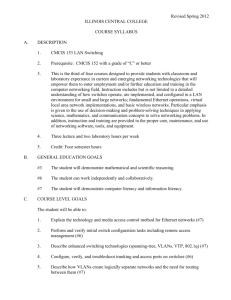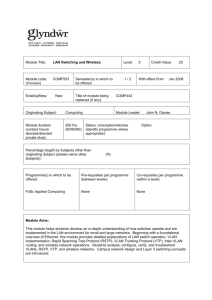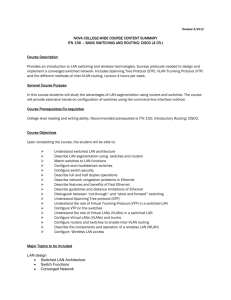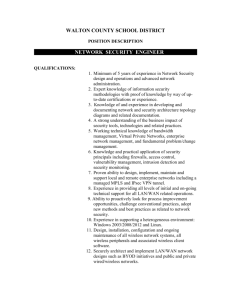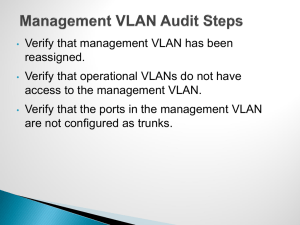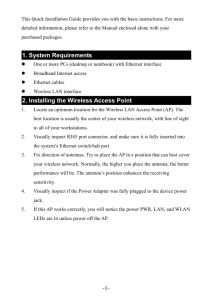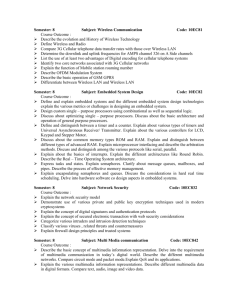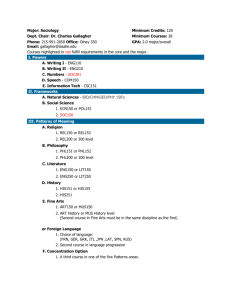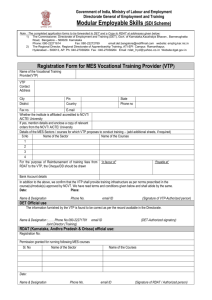CURRICULUM AND INSTRUCTION COMMITTEE
advertisement
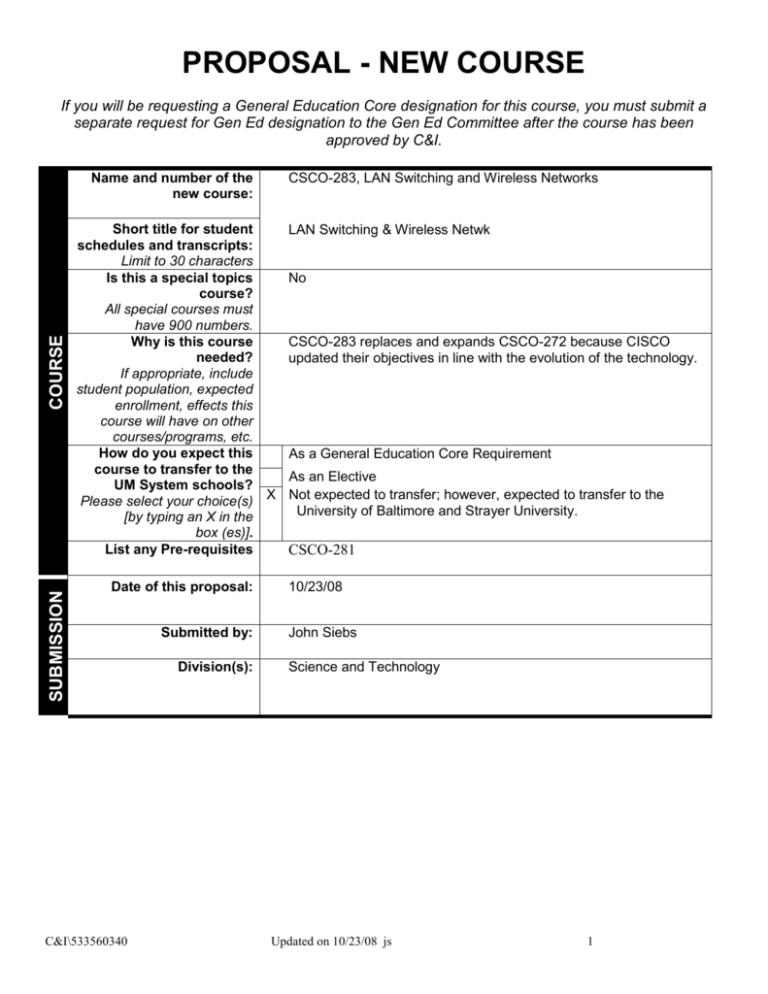
PROPOSAL - NEW COURSE If you will be requesting a General Education Core designation for this course, you must submit a separate request for Gen Ed designation to the Gen Ed Committee after the course has been approved by C&I. SUBMISSION COURSE Name and number of the new course: CSCO-283, LAN Switching and Wireless Networks Short title for student LAN Switching & Wireless Netwk schedules and transcripts: Limit to 30 characters Is this a special topics No course? All special courses must have 900 numbers. Why is this course CSCO-283 replaces and expands CSCO-272 because CISCO needed? updated their objectives in line with the evolution of the technology. If appropriate, include student population, expected enrollment, effects this course will have on other courses/programs, etc. How do you expect this As a General Education Core Requirement course to transfer to the As an Elective UM System schools? Please select your choice(s) X Not expected to transfer; however, expected to transfer to the University of Baltimore and Strayer University. [by typing an X in the box (es)]. List any Pre-requisites CSCO-281 Date of this proposal: C&I\533560340 Submitted by: Division(s): 10/23/08 John Siebs Science and Technology Updated on 10/23/08 js 1 COURSE CONTINUED Degree Audit Please select the course type or types [by typing an X in the box (es)]. CCOMP CFINE CGENED CHIST CHUMA CINTD CLITE CMATH CSOBE CSCIE CSLAB EARSC EBUSI EENGL EFINE EHUMA EMATH EORAL ESCIE ESOSC X OTHER: Composition Core Fine Arts Core Gen Ed Core History Core Humanities Core Interdisciplinary Core Literature Core Math Core Social & Behavioral Science Core Science Core, (used for 3-credit science courses) Science Core, (used for 4 credit science courses with lab) Arts & Science Elective Business Elective English Elective Fine Arts Elective Humanities Elective Math Elective Oral Communications Elective Science Elective Social Science Elective General Elective APPROVAL Electronic signature from the division chair (s): Comments from division chair(s): When saving this file, please use the following naming format: New Course ENGL-999 Attach a standard HCC course outline with this proposal. C&I\533560340 Updated on 10/23/08 js 2 COURSE OUTLINE CSCO-283 LAN Switching and Wireless Networks 3 Semester Hours HOWARD COMMUNITY COLLEGE Description This course helps students develop an in-depth understanding of how switches operate and are implemented in the LAN environment for small and large networks. Beginning with a foundational overview of Ethernet, this course provides detailed explanations of LAN switch operation, VLAN implementation, Rapid Spanning Tree Protocol (RSTP), VLAN Trunking Protocol (VTP), Inter-VLAN routing, and wireless network operations. Students analyze, configure, verify, and troubleshoot VLANs, RSTP, VTP, and wireless networks. Campus network design and Layer 3 switching concepts are introduced. Prerequisite: CSCO-281. (2 hours lecture, 2 hours lab) Overall Course Objectives Upon completion of this course, the student will be able to: 1. 2. 3. 4. 5. 6. 7. 8. 9. 10. 11. 12. 13. 14. 15. 16. 17. 18. 19. 20. 21. 22. 23. Identify and correct common network problems at layers 1, 2, 3, and 7 using a layered model approach. Interpret network diagrams. Select the appropriate media, cables, ports, and connectors to connect switches to other network devices and hosts. Explain the technology and media access control method for Ethernet networks. Explain basic switching concepts and the operation of Cisco switches. Perform and verify initial switch configuration tasks including remote access management. Describe enhanced switching technologies. (VTP, RSTP, VLAN, PVSTP, 802.1q) Describe how VLANs create logically separate networks and the need for routing between them. Configure, verify, and troubleshoot VLANs. Configure, verify, and troubleshoot trunking on Cisco switches. Configure, verify, and troubleshoot interVLAN routing. Configure, verify, and troubleshoot VTP. Configure, verify, and troubleshoot RSTP operation. Interpret the output of various show and debug commands to verify the operational status of a Cisco switched network. Verify network status and switch operation using basic utilities (ping, traceroute, telnet, SSH, arp, ipconfig), SHOW & DEBUG commands. Identify, prescribe, and resolve common switched network media issues, configuration issues, autonegotiation, and switch hardware failures. Manage Cisco IOS. Manage IOS configuration files. (save, edit, upgrade, restore) Describe standards associated with wireless media. (IEEE WI-FI Alliance, ITU/FCC) Identify and describe the purpose of the components in a small wireless network. (SSID, BSS, ESS) Identify the basic parameters to configure on a wireless network to ensure that devices connect to the correct access point. Compare and contrast wireless security features and capabilities of WPA security (open, WEP, WP-1/2). Identify common issues with implementing wireless networks. (Interference, Misconfiguration) C&I\533560340 Updated on 10/23/08 js 3 Major Topics I. Local Area Network (LAN) Design A. Switched LAN Architecture B. Matching Switches to Specific LAN Functions II. Basic Switch Concepts and Configuration A. Introduction to Ethernet/802.3 LANs B. Forwarding Frames Using a Switch C. Switch Management Configuration D. Configuring Switch Security III. Virtual Local Area Networks (VLANs) A. Introduction to VLANs B. VLAN Trunking C. VLAN and Trunk Configuration D. VLAN and Trunk Troubleshooting IV. VLAN Trunking Protocol (VTP) A. VTP Concepts B. VTP Operation C. VTP Configuration V. Spanning Tree Protocol (STP) A. Redundant Layer 2 Topologies B. Introduction to STP C. STP Convergence D. Cisco and IEEE STP Variants VI. Inter-VLAN Routing A. Introduction to Inter-VLAN Routing B. Inter-VLAN Routing Configuration C. Inter-VLAN Routing Troubleshooting VII. Basic Wireless Concepts and Configuration A. The Wireless LAN B. Wireless LAN Security C. Wireless LAN Access Configuration D. Troubleshooting Simple Wireless LAN Problems Course Requirements Grading/exams: Grading procedures will be determined by the individual faculty member but will include the following: Final grades will be based primarily on homework, lab exercises, lab practical and final exam. Other Course Information This course is a course in Electronics Technology, Telecommunications Technology, and Computer Support Technology Programs. This course is also intended for students who wish to become a Cisco Certified Network Associate. C&I\533560340 Updated on 10/23/08 js 4
